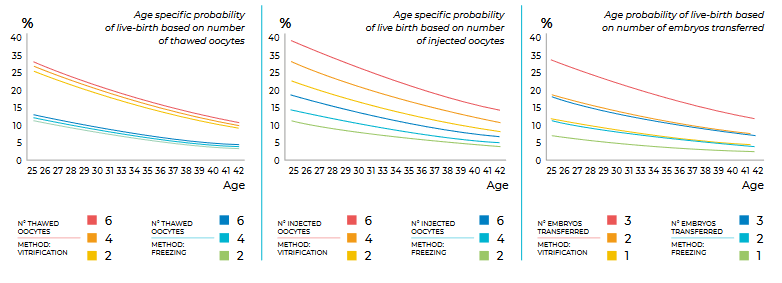We live in the information society, which gives us the power to choose based on knowledge and helps us to make decisions. There are certain social factors in Spain that cause people to postpone having children: the difficulty of accessing housing, low emancipation rate, precarious jobs, not finding a stable partner and difficult work-family balance, among others.
Since some of these factors are beyond our control, we need to find solutions that will allow us to delay and plan motherhood for the future. One of them is the vitrification of eggs (in other words, the freezing of women’s gametes). I’m going to explain this technique through questions and answers, just as we would do if we were at an appointment.
Below is a graph of the results by age based on the number of frozen oocytes.

What does the freezing / vitrification of oocytes consist of?
The freezing, or vitrification, of oocytes is a technique for the cryopreservation of women’s gametes for reproductive purposes. Prior to the freezing, the ovaries are stimulated with gonadotropins aimed at multifollicular ovarian development; this will make it possible to obtain several oocytes in a single ovarian cycle.
What is the survival rate of the oocytes?
The oocyte survival rate after freezing is about 90-97%, and the percentage of pregnancy per oocyte being 4.5%-12%.
When is the best age to vitrify my eggs?
Medically speaking, the ideal age is women under 35. However, egg vitrification is also possible later, although the results may be less optimal.
Why is it so important to do it at certain ages?
Pregnancy results and rates are much better due to the deleterious effects of age on the ovarian reserve (see the graph).
How can a woman’s ovarian reserve be determined?
There are different tools for measuring the ovarian reserve. We can make an estimate by using ultrasound to count the antral follicles in the ovaries, or by using an anti-mullerian hormone laboratory test.
What does it do?
It assesses the capacity of the ovary to respond to stimulation treatment.
What women can benefit from the freezing of oocytes?
There are various patients who can benefit from vitrification:
- Women who want to postpone motherhood for work/personal reasons.
- Cancer patients undergoing treatments that may reduce their ovarian reserve.
- Patients who are going to undergo ovarian surgery that may compromise the remaining ovarian tissue, such as, for instance, endometriosis.
- Patients with other health problems that may compromise their ovarian reserve such as autoimmune diseases, a history of early ovarian failure, etc.
How long can the oocytes be preserved for?
The law allows them to be preserved until the woman’s reproductive activity stops, at about 50 years of age.
Is there any prior preparation before the egg extraction procedure, such as medication, hormones, diet, lifestyle, time in the cycle, etc.?
Prior to treatment, a general health assessment is carried out in order to detect whether there are matters that may be improved before ovarian stimulation, either through medical treatment or lifestyle modifications. Once corrected, the treatment is done by stimulation using injected medication.
How long does this type of treat-
ment last?
Between 8 and 10 days. It’s started at the beginning of the ovarian cycle, that is, when menstruation begins.
Can normal activities be continued during the treatment?
Women can continue practically their normal activities during the entire treatment. During the last days, a woman may note a bit more bloating, so we recommend reducing the pace of impact sports, such as jumping.
What are its side effects?
Side effects come from hormonal production, and they may be the same as those that occur when menstruation begins, with a feeling of a bloated abdomen, breast tenderness, headaches in some cases, and so on. But these are symptoms that – because the treatment is so short – appear at the end (and not always) and recede quickly.
Is the extraction procedure difficult?
It’s a minor procedure that lasts some 10-15 minutes, and is done with the patient sedated to prevent any discomfort.
Are there any contraindications?
Health contraindications must be determined individually in each case but, in general, this procedure has no contraindications.
What are the risks of undergoing this procedure?
Like any medical intervention, there may be associated risks. These are determined individually in each case and are explained in informed consent prior to treatment.
How long does it take to recover and return to normal life after the procedure?
Recovery is very quick. Women can practically return to their normal activities one day after the puncture, and completely after one week.
In short, this is a simple technique that allows us to preserve oocytes that can be used in the future. lt allows us to have a Plan B, if we ultimately decide to try to get pregnant, and to reduce the effects of ageing that inevitably affect our ovaries.





